The Ark of the Covenant
Hidden for 2,600 years
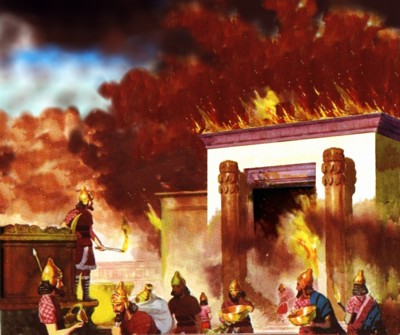
This reveals that these items never came into the possession of the Babylonian army. Jewish traditional writings, e.g. The Paralipomena of Jeremiah, indicate that these important items were hidden just prior to the Babylonian invasion.
Warned of the impending destruction, the prophet Jeremiah is said to have secreted the items in a cave. When the Temple was rebuilt in later years, the instructions for the rebuilding of the Temple fails to make any mention of the Ark being re-instated. Jeremiah had written that the Ark would be no more restored to the people for Israel (Jeremiah 3:16), and so it is evident that the Ark has remained hidden, its whereabouts unknown - that is until modern times.
Since the Hollywood film Raiders of the Lost Ark there has been a proliferation of unsuccessful attempts to find the Ark. But now, through someone who never planned to look for it, it's exact whereabouts has been established finally.
below 2&3. Difficult and dangerous work during the excavation.

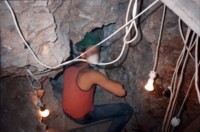
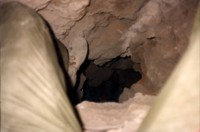
Discovered near Jerusalem
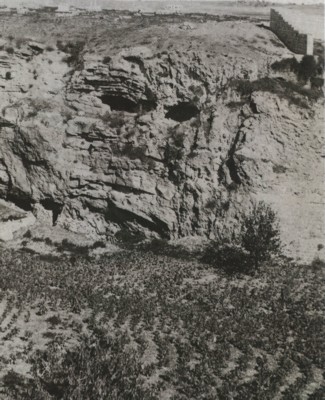
At the time, Ron was conversing with an influential person from the Department of Antiquities, who subsequently offered to provide the necessary permits for Ron to begin excavating at the site. Ron knew the experience was supernatural. But before accepting the offer, he decided to return to the United States to research the subject more thoroughly. After studying the subject carefully, he felt that the location pointed to was quite within the realms of possibility.
In 1979 he returned to begin excavating. Over the centuries, Jerusalem has been destroyed and rebuilt several times, and each time the new city has been simply reconstructed on top of the old. Therefore Ron's crew had to remove many tons of rock and debris in the course of their excavation. All of it was sifted through for artifacts, a requirement of the Department of Antiquities, which they would always comply with.
Ron and his team dug along the base of the escarpment where he had pointed, in the vicinity of the "skull-face", a known Roman crucifixion site.
During the next two years, in between his obligations as an anaesthetist, Ron and his team made some wonderful discoveries, and provided details to the authorities of their finds, along with any artifacts they retrieved. As they excavated along the cliff face, they came to a base of bedrock with some squarish holes. Ron surmised that they were cross holes. They were approximately 12 inches square and the central one was covered with a stone plug, apparently to keep debris from falling into the hole when it was not being used. Ron also noticed that there was a large crack that extended down the cliff face and into this central cross hole. It would be over a year later before he would learn that this crack extended 20 feet into the bedrock.
Considering they were excavating close to the "Skull face" on the Golgotha escarpment, Ron knew they had found the probable place of Christ's execution. The fact that the location was in the area of the Calvary escarpment and fit a number of aspects of the Biblical description made it a likely spot. However, Ron was not searching for the crucifixion site but the Ark of the Covenant. So he continued to search the cliff face for an opening of some kind. If the Ark was in that location, it certainly would be hidden in a cave, Ron knew.
Finally, the decision was made to break through the rock of the cliff-face. The rock is extremely hard, and it was difficult work, yet it wasn't long before they broke through into an open space. Enlarging the hole, they found the mountain was honeycombed with natural cavities and tunnels. Crawling through, they were inside the actual mountain called Moriah. Ron and the team spent many hours chiselling through cave walls, searching for adjacent tunnels. This was difficult, arduous work, and took a toll on both health and spirits. But the work would ultimately pay dividends.
In 1982 he finally located the cave chamber which held the long-lost temple items. Ron was to later realise that had he discovered the chamber containing the Ark of the Covenant without first searching the base of the Calvary escarpment, it is very unlikely he would have discovered the original crucifixion site. He then knew that providence had led in the circumstances prior to and during the entire excavation. It was not human wisdom which led to this discovery.
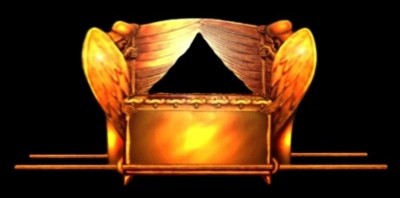
The chamber was about 22 feet by 12 feet, although not exactly rectangular as one corner narrowed in. The chamber was filled almost to the ceiling with rocks. Beneath the rocks were dry-rotted timbers and dry-rotted animals skins, apparently undisturbed for quite some time . Beneath the rocks, timbers and animal skins were missing items from the first temple, including the Table of Shewbread. At the far end of the chamber was a stone case, and housed within the stone case was the Ark of the Covenant (above artists interpretation) , complete and intact, except that the carrying staves had been removed. Ron was the first human to set eyes on these priceless items since they had been secreted from the city prior to it's destruction in 586BC. But the biggest surprise was yet to come.

OF all the discoveries made by Ron Wyatt, perhaps none is more significant than the finding of the Ark of the Covenant.
On it's own, the Ark would be a tremendously important find. However, an incredible connection between the crucifixion site and the Ark below gives this discovery a significance beyond measure. So significant and far-reaching is this connection that it is destined to change the lives and faith of millions.
When Ron Wyatt discovered the original crucifixion site during the excavation near Golgotha, he found there was a large crack, probably an earthquake fault, in the limestone bedrock beside the central cross hole. Later, when he entered the chamber where the Ark of the Covenant was hidden, he found a large crack the ceiling directly above the Ark of the Covenant.
Around this crack, and upon the lid of the Ark itself, was a dark, dried substance. This dark substance was analysed, and confirmed the suspicions that this substance was very old human blood.
By inserting a metal tape measure, it was determined that the crack ran continuously from the cross site above to the chamber beneath, through about 20 feet (7 m) of rock.
Ron had discovered that when Christ had died, and the Roman soldier had pierced his side, the blood and water which flowed from Christ's side had gone down the crack in the rocks, and spilled onto the lid of the Ark of the Covenant, hidden in the chamber beneath Calvary many years before.

FOR hundreds of years the Hebrews had carried out a system of animal sacrifice, consisting of Divinely appointed ceremonies which were an on-going reminder that they had a Covenant with God.
Today we refer to this Covenant as the Old Covenant. It was instituted and ratified at Mt Sinai. The ceremonies of this covenant had deep meaning, for they foreshadowed actual events to take place when the New Covenant would instituted under the Messiah. The New Covenant was foretold by the prophet Jeremiah (Jeremiah 31:31).
The Ark of the Covenant was the centrepiece in the old ceremonial system. It's primary purpose was to house the sacred tables of stone, upon which God himself had written the 10 commandments with His own finger. When Ron Wyatt discovered the Ark of the Covenant, he also discovered the physical evidence of the ratifying of the New Covenant.
In the same way the Old Covenant had been ratified at Mount Sinai, so the New Covenant was ratified at Calvary. In the Old Covenant, sacrificial blood and water was sprinkled upon the "book of the Covenant". In the New Covenant, the blood and water from Christ's pierced side went into the earth, and landed upon the Ark of the Covenant containing the 10 commandments.